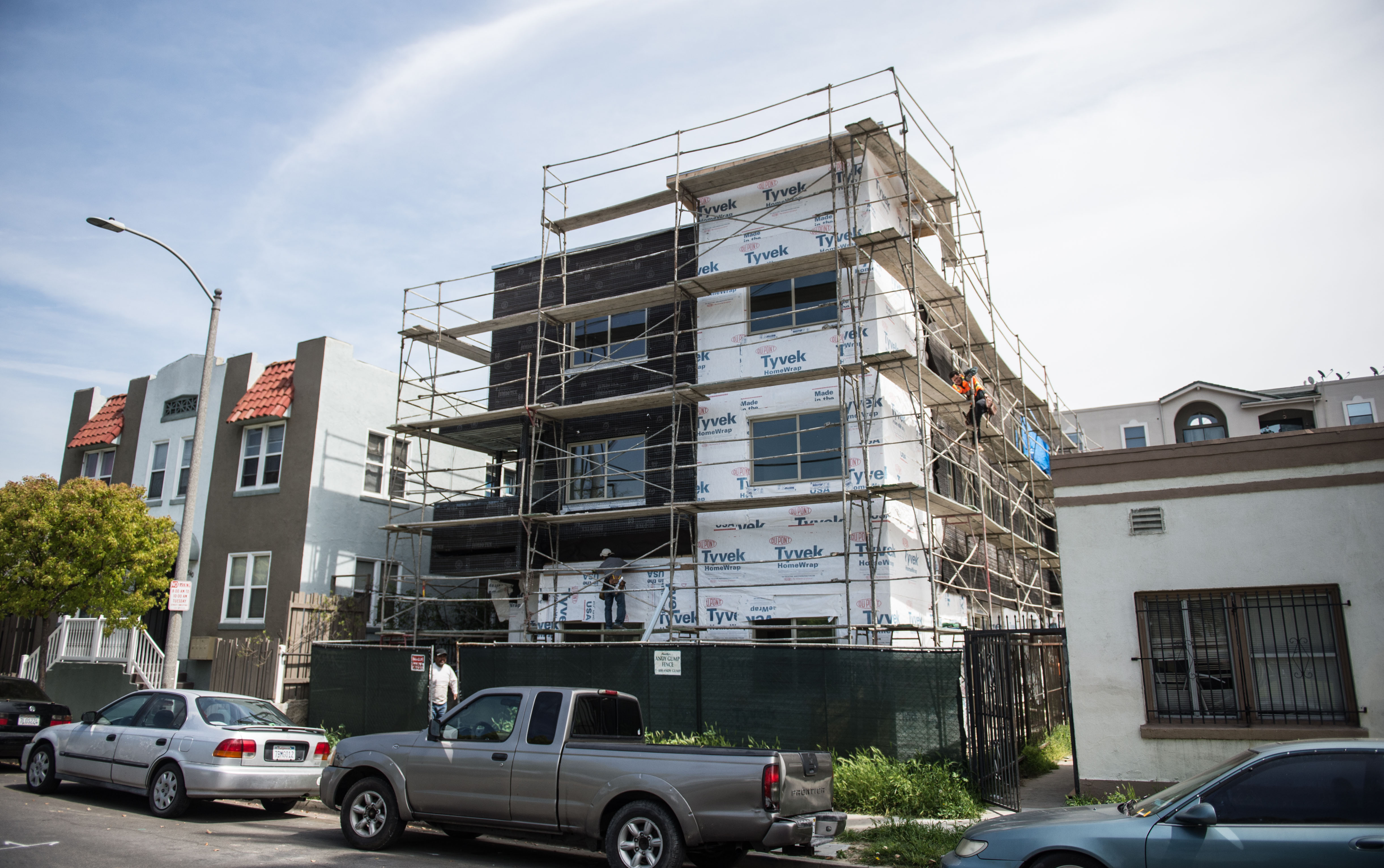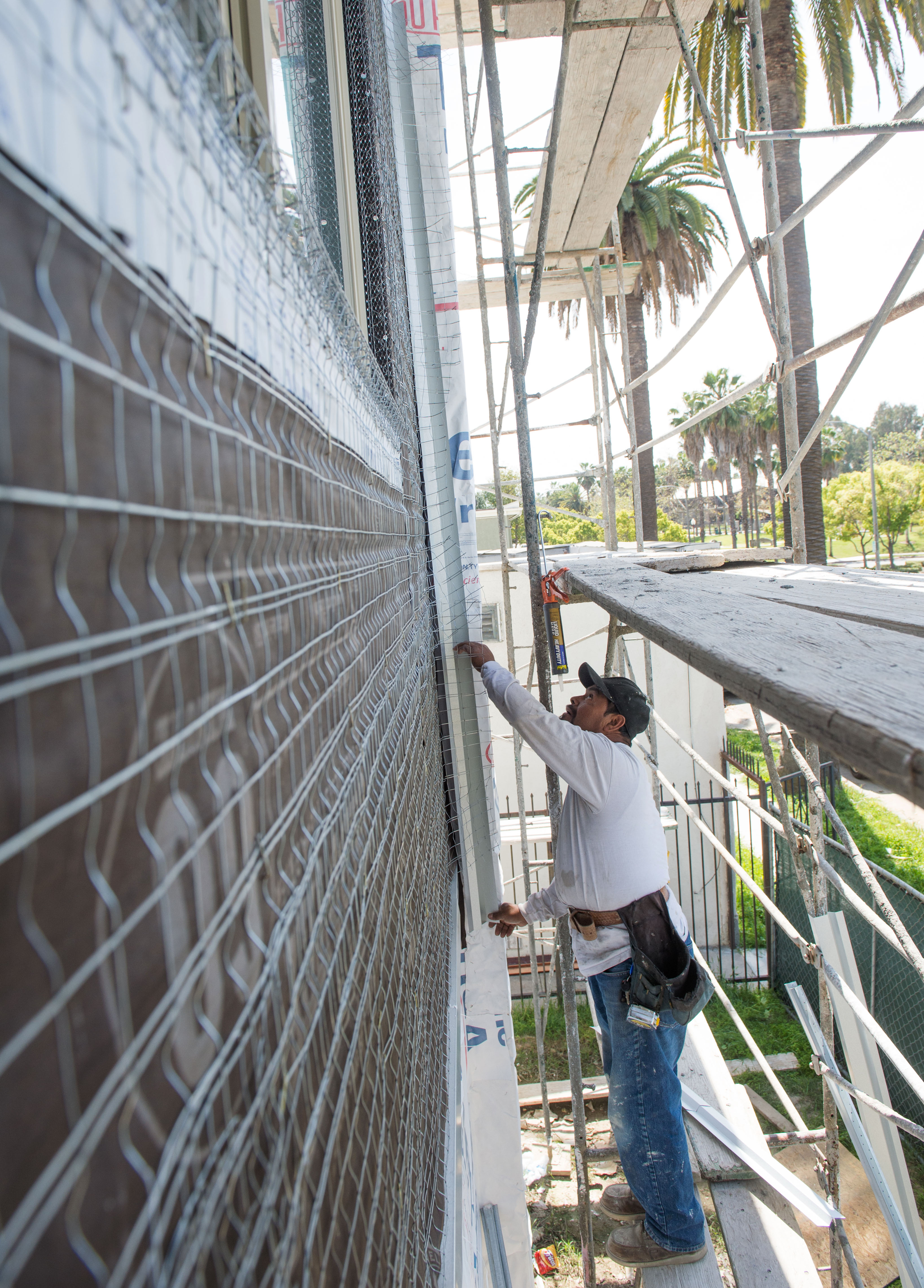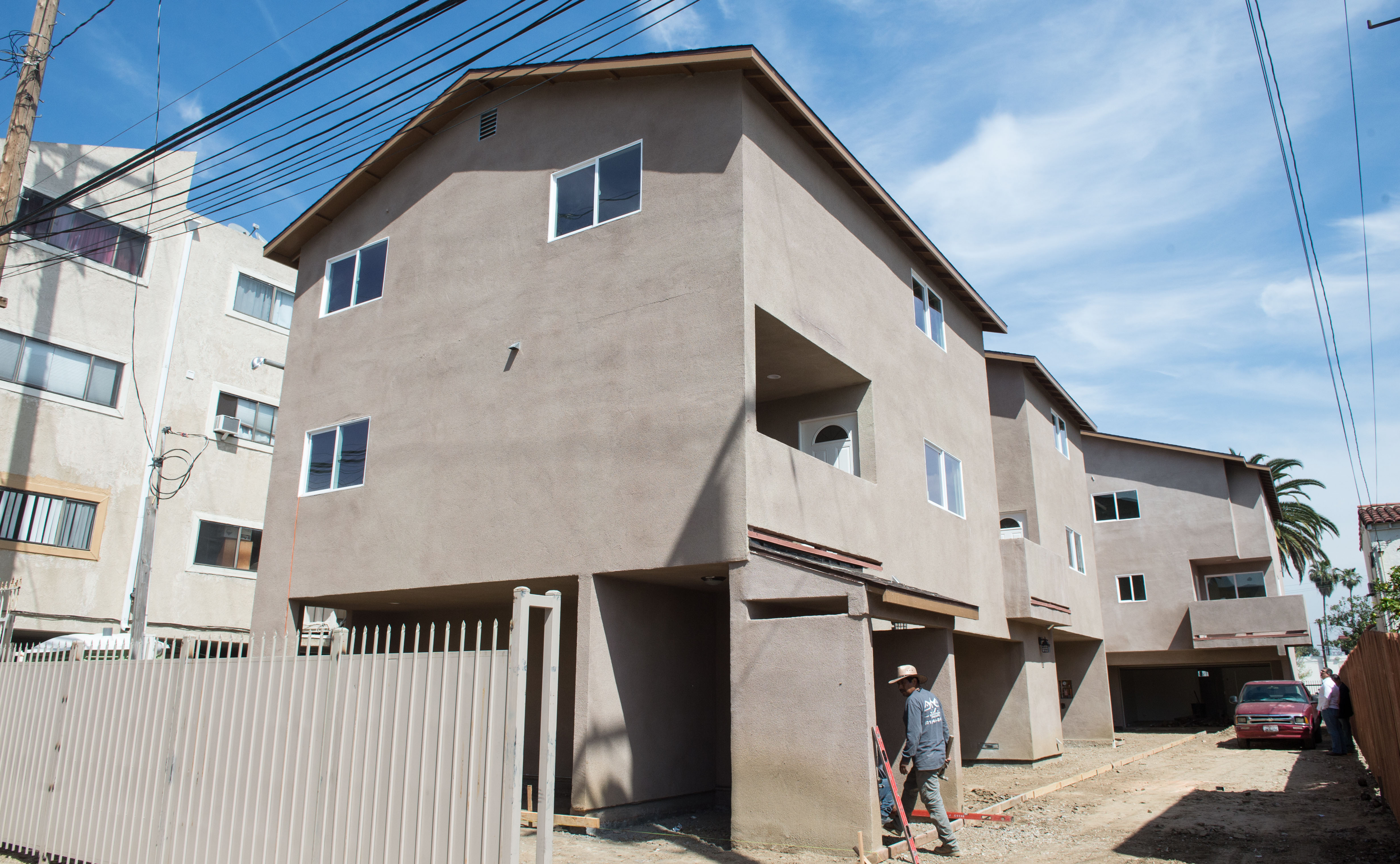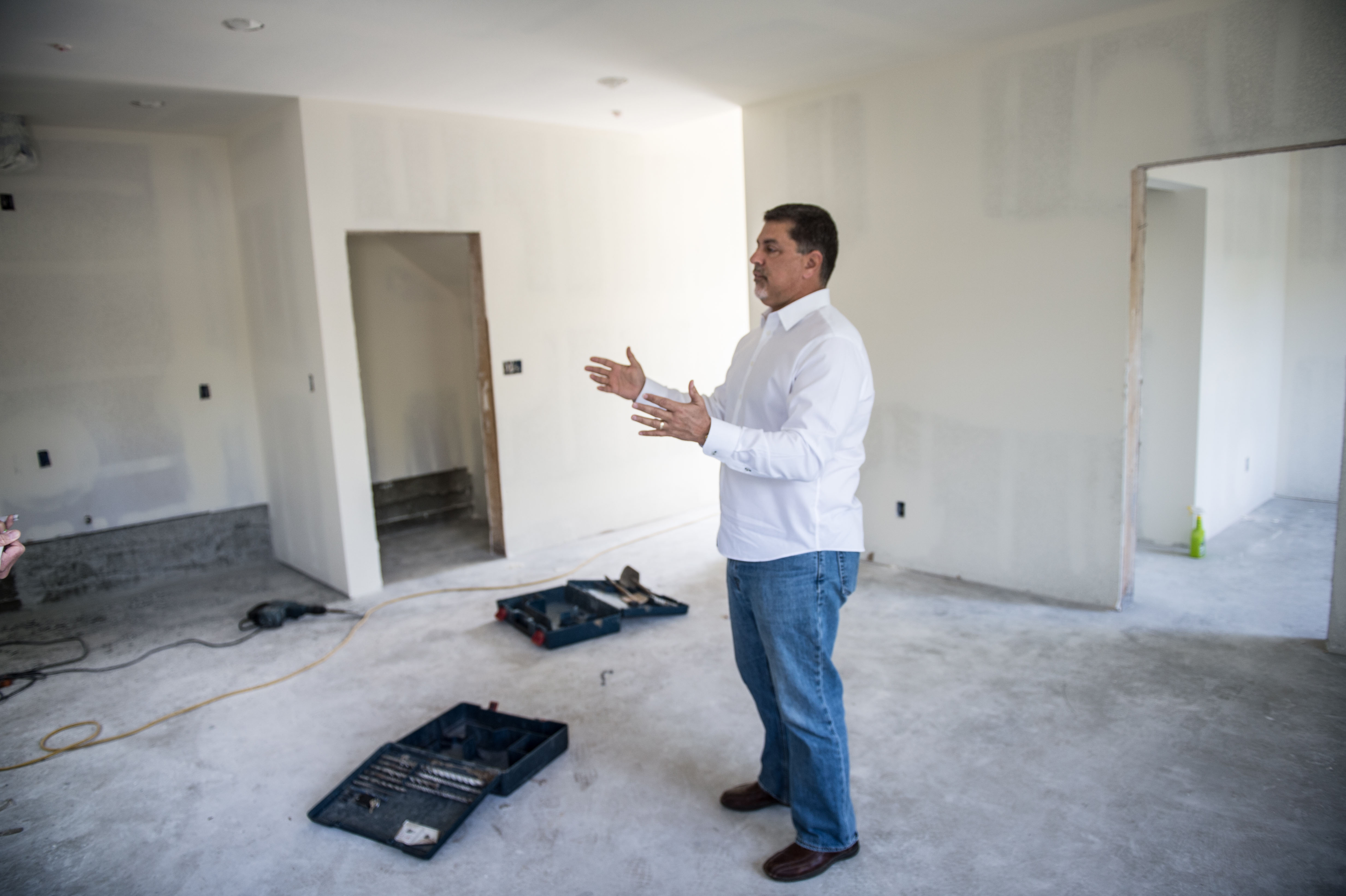A three-story apartment development nested between Cesar E. Chavez Park and a sea of densely-packed aging apartment complexes isn’t much to look at, but its developer believes it can be a small part of a solution to Southern California’s housing shortage.
“Small” is the key word, considering it’s only three units.
Then again, the apartment development going up 538 Golden Ave. has the potential to pack in residents without necessarily being crowded, and to benefit an underserved community of multi-generational families. The five-bedroom townhouse units aim to provide workforce housing to large families that typically pool their resources – two to four wage earners consisting of parents, children and grandparents all under the same roof, for example. These are families who may share cars and help one another economically.

Three story apartment development, near Cesar Chavez Park, 538 Golden Avenue. The multifamily, three unit development is intended to house families of up to eight people each. The concept is referred to by developer Scott Choppin, of The Urban Pacific Group, as an urban town house. Long Beach California, March 25, 2019.
Photo by Stephen Carr
Scott Choppin, founder of Long Beach-based The Urban Pacific Group of Cos., calls the apartment concept an Urban Town House. He’s working on trademarking the name.
Multi-generational households have been on the rise for decades, according to a study from the Pew Research Center that showed 57 million Americans were living in multi-generational households in 2012, double the number from 1980. Having multiple generations together under one roof spiked following the Great Recession in 2007, and kept on growing after the recession ended, according to Pew. The latest data, released in 2018, shows that by 2016 there were 64 million Americans, or 20% of the U.S. population, living multi-generationally. People marrying later, immigration, health and disability and economic conditions are factors in this trend, according to Generations United.
“It’s intended to house working families that would live in a larger family group,” Choppin said of his development. “The idea is to have six to eight people typically living in a unit. They are living multi-generationally. They’re operating as a family unit.” He expects the 1,850- to 2,000-square foot units to go for roughly $3,500 per unit.

Abel Rodriguez works on the outer walls of a three story apartment development near Cesar Chavez Park, 538 Golden Avenue. Multifamily three unit development, intended to house families of up to eight people each. The concept is referred to by developer Scott Choppin, of The Urban Pacific Group, as an urban town house. Long Beach California, March 25, 2019.
Photo by Stephen Carr
That cost isn’t far off from what a family may pay for a typical mortgage for a one-family home in Southern California. The developer believes each unit can provide a similar feel to a single-family home despite the intent of getting far more people into one dwelling. “It lives like a house,” Choppin said.
He views these as “demonstration” projects, which he hopes will be an example of what can be done in a small space. He received no subsidy or government assistance, he added.
“I’m happy to claim we invented this in Long Beach,” he said.
Choppin has done several Urban Town House (UTH) projects, and has more underway:
-
325 Daisy Ave., Long Beach: two units complete
-
1719 Cedar Ave., Long Beach: four units; construction complete and leasing
-
538 Golden Ave., Long Beach: three units; construction expected to be completed in June
-
3801 Franklin Ave., Fullerton: seven units; under construction
-
1029 S. Montebello Ave., Montebello: 15 units; construction to begin in August
-
3705 Monterey, El Monte: 94 units; in entitlement process
“We will have a number of moderate-income sites tied up in Ontario here shortly,” Choppin said. Some of these projects are being built on lots that are only big enough to accommodate one large home, or two small ones.
His 7,500 square-foot project at 1719 Cedar Ave. will yield four units at between 1,690 and 1,800 square feet. The five-bedroom, four-bath units, which he developed with partners Neal Thompson and David Sazegar, is on the market for $1.9 million. Considering each unit is built for roughly eight occupants, the project should house about 30 people.

1719 Cedar Avenue. A multifamily four unit development, intended to house families of up to eight people each. The concept is referred to by developer Scott Choppin, of The Urban Pacific Group, as an urban town house. Long Beach California, March 25, 2019.
Photo by Stephen Carr
Choppin’s business plan, which was initiated in 2017, calls for either selling or keeping the developments and then leasing them himself.
He plans to sell the Golden complex, and he stands to make a decent profit considering he paid a mere $240,000 for the 5,900-square-foot acre parcel. “We think this will go on the market for $1.5 million,” he said.
That initial investment also yields another advantage. Developers like Choppin don’t require backing from large corporations. “Our investors are predominantly high-net-worth individuals and families,” Choppin said. “We are starting to get traction in family office, groups that manage capital for high net worth, and ultra-high net worth family groups. As well, we are getting interest from institutional and opportunity zone capital sources as we speak.”
Choppin, 51, seems to have development in his blood. He is a third generation Long Beach resident who started in the development game working for his father, Kerry, at age 16. His son Sean is a 17-year-old in his senior year at Wilson High School. He was accepted to USC and plans to start in the fall in the school’s bachelor of real estate development program.

Developer Scott Choppin inside his three story apartment development , near Cesar Chavez Park, 538 Golden Avenue. The multifamily, three unit development, is intended to house families of up to eight people each. The concept is referred to by Choppin, of The Urban Pacific Group, as an urban town house. Long Beach California, March 25, 2019.
Photo by Stephen Carr
Choppin’s uncle, Michael, founded Investment Development Management Corp., the developers of the World Trade Center in joint venture with Kajima Corp. So when he speaks about his UTH concept, it’s hard for him to contain his excitement.
Choppin said construction costs, funded through small loans and private equity, on the developments are kept low by using the same subcontractors on multiple projects, and that building similar units over and over allows them to refine and speed production, and keep projects streamlined. “Cost efficiently is a primary part of the UTH model,” he said.
Choppin has discussed the projects with staff at the city mayor’s office, and with staff in the city’s housing and economic development departments to get them to encourage more such development, and he hopes those conversations prove to be fruitful. Choppin said he’s still waiting for feedback from the city.
“One of the things I tell everyone: this UTH model was created and executed in Long Beach. It might be a great idea to have the city get some credit for the first to have privately financed moderate-income housing built in its city,” he said.
Meanwhile, Choppin said he’ll continue to scour the city’s lower to middle-end areas looking for parcels and beating the drum for whoever will listen that his concept should be considered as part of any solution to the housing shortage. “We’re, at many levels, looking at a marketplace that is untouched,” he said.


Comments are closed.